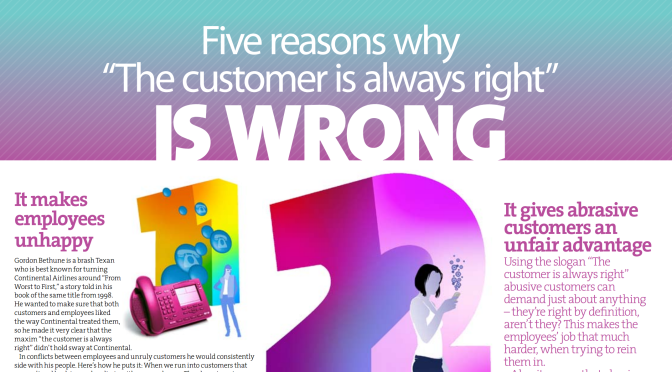My article on
why “The Customer is Always Right” is wrong has generated an amazing amount of attention. It’s been read by 100,000s of people and been mentioned all over the internet.
 Call Center Magazine in the UK liked it so much that they turned it into a wall chart that is waaaaay more attractive than my original post. Download it here.
Call Center Magazine in the UK liked it so much that they turned it into a wall chart that is waaaaay more attractive than my original post. Download it here.
But most of all the article gets a LOT of great comments. Here are some of my favorites.
Chris wrote:
I run a small company with about 20 employees. One day I heard commotion coming from the reception area. I hear a man yelling “I am the customer, you work for me and the customer is always right!”. I immediately went up and said, “No sir, you can’t get away with what you get away with at Walmart here. This young lady works for me and no matter what you think you were right about, you raised your voice and are no longer welcome.”
He needed our services and wrote a letter of apology for his ‘cranky mood’.
You raise your voice and you are out. No exceptions.
That’s it in a nutshell.
Grant wrote:
I read this post the other day and it was hiding in the back of my mind then this past Thursday I had a job interview. The interviewer asked me, “What do you feel about the statement, ‘The customer is always right’?” I remembered this post and mentioned these points as well as embellished to make it more appropriate to the job description.
After I answered that, the interviewer told me that I was the first person all day to answer that question correctly (she had already interviewed 6 people). Today I got a call offering me the position. I’d like to think that it had something to do with this blog post.
Thanks :)
SEE MOM! BROWSING THE INTERNETS IS A GOOD THING!!!
I’ve told Grant that I take full credit for him getting the job and given him an account number where he can deposit 10% of his first year’s salary :o)
Marie wrote:
We recently had a customer who bounced a check, and had the audacity to call my customer service manager with a tirade of yelling & profanity (before she could explain what had happened). She was calm and waited for him to settle down and tried to explain… He continued to use profanity, only to stop when my CS Manager politely told him that if he didn’t quit, she would hang up… Later, he emailed a complaint to the corporate office stating how rude and unprofessional she had been…
The customer DOES NOT have the right to harass my employees. I just happened to be in the office that day and could hear him screaming at her over the phone. I think she handled it WONDERFULLY; I took her out to lunch!
I don’t believe that a customer has the right to verbally assault my employees and I have trained them not to take that type of abuse from anyone.
SueBob writes:
I worked at a print shop where my manager would occasionally fire customers. In four years, I think it was 3 people. He told one person, “I won’t have you abuse my employee.”
I would have crawled through broken glass for him. It was one of the best employment experiences of my life.
These comments show that there are many companies out there that realize that putting the employees first actually results in better customer service. The formula is simple: Happy employees = happy customers.
But of course not everyone gets it. Yet.
Anonymous writes:
I work in a call center and showed this article to my boss. I’m told that senior managers view the ideas presented here as “silly.” Is it any wonder employees think our company is out to get them?
Customers are allowed to verbally abuse our employees and this is supposed to be a sign of great customer service. All the while, lower level managers are directed to keep turnover down. The company doesn’t understand that people are not satisfied in a job where the company supports abuse towards them.
Get a clue.
Sheeesh!
Related posts


 So far, I’ve spoken about happiness at work in 32 different countries but I have an ambition to add more. The top 3 countries I’d love to speak in are:
So far, I’ve spoken about happiness at work in 32 different countries but I have an ambition to add more. The top 3 countries I’d love to speak in are:
